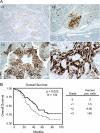Overexpression of elafin in ovarian carcinoma is driven by genomic gains and activation of the nuclear factor kappaB pathway and is associated with poor overall survival
- PMID: 20126474
- PMCID: PMC2814354
- DOI: 10.1593/neo.91542
Overexpression of elafin in ovarian carcinoma is driven by genomic gains and activation of the nuclear factor kappaB pathway and is associated with poor overall survival
Abstract
Ovarian cancer is a leading cause of cancer mortality in women. The aim of this study was to elucidate whether whey acidic protein (WAP) genes on chromosome 20q13.12, a region frequently amplified in this cancer, are expressed in serous carcinoma, the most common form of the disease. Herein, we report that a trio of WAP genes (HE4, SLPI, and Elafin) is overexpressed and secreted by serous ovarian carcinomas. To our knowledge, this is the first report linking Elafin to ovarian cancer. Fluorescence in situ hybridization analysis of primary tumors demonstrates genomic gains of the Elafin locus in a majority of cases. In addition, a combination of peptidomimetics, RNA interference, and chromatin immunoprecipitation experiments shows that Elafin expression can be transcriptionally upregulated by inflammatory cytokines through activation of the nuclear factor kappaB pathway. Importantly, using a clinically annotated tissue microarray composed of late-stage, high-grade serous ovarian carcinomas, we show that Elafin expression correlates with poor overall survival. These results, combined with our observation that Elafin is secreted by ovarian tumors and is minimally expressed in normal tissues, suggest that Elafin may serve as a determinant of poor survival in this disease.
Figures






Similar articles
-
Elafin drives poor outcome in high-grade serous ovarian cancers and basal-like breast tumors.Oncogene. 2015 Jan 15;34(3):373-83. doi: 10.1038/onc.2013.562. Epub 2014 Jan 27. Oncogene. 2015. PMID: 24469047 Free PMC article.
-
Analysis of gene amplification and prognostic markers in ovarian cancer using comparative genomic hybridization for microarrays and immunohistochemical analysis for tissue microarrays.Am J Clin Pathol. 2006 Jul;126(1):101-9. doi: 10.1309/n6x5mb24bp42kp20. Am J Clin Pathol. 2006. PMID: 16753589
-
Nicotinamide N-methyltransferase overexpression may be associated with poor prognosis in ovarian cancer.J Obstet Gynaecol. 2021 Feb;41(2):248-253. doi: 10.1080/01443615.2020.1732891. Epub 2020 Apr 14. J Obstet Gynaecol. 2021. PMID: 32285726
-
Amplification of the ch19p13.2 NACC1 locus in ovarian high-grade serous carcinoma.Mod Pathol. 2011 May;24(5):638-45. doi: 10.1038/modpathol.2010.230. Epub 2011 Jan 14. Mod Pathol. 2011. PMID: 21240255 Free PMC article.
-
EZH2 supports ovarian carcinoma cell invasion and/or metastasis via regulation of TGF-beta1 and is a predictor of outcome in ovarian carcinoma patients.Carcinogenesis. 2010 Sep;31(9):1576-83. doi: 10.1093/carcin/bgq150. Epub 2010 Jul 28. Carcinogenesis. 2010. PMID: 20668008
Cited by
-
Profiles of genomic instability in high-grade serous ovarian cancer predict treatment outcome.Clin Cancer Res. 2012 Oct 15;18(20):5806-15. doi: 10.1158/1078-0432.CCR-12-0857. Epub 2012 Aug 21. Clin Cancer Res. 2012. PMID: 22912389 Free PMC article.
-
The polyoma virus large T binding protein p150 is a transcriptional repressor of c-MYC.PLoS One. 2012;7(9):e46486. doi: 10.1371/journal.pone.0046486. Epub 2012 Sep 28. PLoS One. 2012. PMID: 23029531 Free PMC article.
-
Human epididymis protein 4 is up-regulated in gastric and pancreatic adenocarcinomas.Hum Pathol. 2013 May;44(5):734-42. doi: 10.1016/j.humpath.2012.07.017. Epub 2012 Oct 16. Hum Pathol. 2013. PMID: 23084584 Free PMC article.
-
Effect of ischemia-reperfusion injury on elafin levels in rat liver.Ulus Travma Acil Cerrahi Derg. 2024 Feb;30(2):80-89. doi: 10.14744/tjtes.2024.32728. Ulus Travma Acil Cerrahi Derg. 2024. PMID: 38305656 Free PMC article.
-
Clinical significance of PI3 and HLA-DOB as potential prognostic predicators for ovarian cancer.Transl Cancer Res. 2020 Feb;9(2):466-476. doi: 10.21037/tcr.2019.11.30. Transl Cancer Res. 2020. PMID: 35117391 Free PMC article.
References
-
- Jemal A, Siegel R, Ward E, Hao Y, Xu J, Murray T, Thun MJ. Cancer statistics, 2008. CA Cancer J Clin. 2008;58:71–96. - PubMed
-
- Stewart B, Kleihues P. WHO World Cancer Report. Lyon, France: IARC Press; 2003.
-
- Cannistra SA. Cancer of the ovary. N Engl J Med. 2004;351:2519–2529. - PubMed
-
- Bast RC., Jr Status of tumor markers in ovarian cancer screening. J Clin Oncol. 2003;21:200–205. - PubMed
Publication types
MeSH terms
Substances
Grants and funding
LinkOut - more resources
Full Text Sources
Medical
Research Materials
